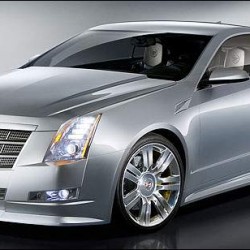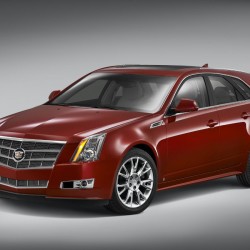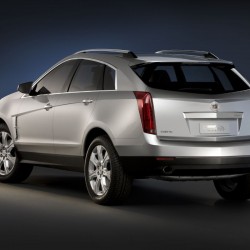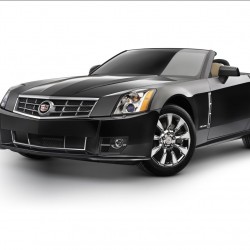Will MPG requirements hurt the future of Cadillac
With rising gas prices and increases in CAFE (Corporate Average Fuel Economy) standards set to take effect in the coming decade, the future of Cadillac's products is in doubt.
Rumors are swirling that the STS/DTS replacement (both cars were to be replaced with a single uber-model to compete against BMW's 7-series and Mercedes S-Class), expected to be built on a premium version of GM's new Zeta rear-drive chassis, has been canceled. The next Escalade is up in the air. Smaller products are being considered that might never have been before.
This casts doubt onto the direction Cadillac might take in the future. Will they continue on their quest to go toe-to-toe with the luxury industry heavyweights model for model (and with the new regulatory climate, what does that mean)? Will they dial back their ambition and compete with the second tier of the luxury market? Will they find their own, distinctive, path?
Let's take a look at what will and might happen at Cadillac in the near future:
CTS variants - We know that the CTS is the shining star of Cadillac's rebirth. In it's second generation it has silenced critics that thought GM incapable of understanding, much less producing, a competitive product in this space. Instead Cadillac has wowed the world with a car some call 'the best American car ever.'
 To follow up the sedan are a string of variants that show Cadillac understands the way luxury makers turn a profit, and it isn't with their low-volume, high-dollar models (those merely help to give the brand luxury credibility) - it is with an attainable car in several flavors. An ultra-quick V version of the sedan hits the ground later in 2008 with hard-won credibility in its segment through mastery of the 'Ring (owning the record for fastest lap by a production sedan, and with an automatic transmission of all things). In the first half of 2009, we will get a Sport Wagon version that will appeal to export markets (specifically Europe) and a few non-conformists in the US. Following that, the CTS coupe will hit the street in sexier sheet metal than anyone could have expected and with plenty of unique design elements than telegraph that business as usual is no longer ruling within GM's walls. Simultaneously, V versions of the wagon and coupe will almost certainly appear to give a fully fleshed-out line from the beginning. Ultimately, it appears the only conceivable version of the CTS we'll be lacking is a convertible. We can only hope GM makes a business case eventually for a drop-top version.
To follow up the sedan are a string of variants that show Cadillac understands the way luxury makers turn a profit, and it isn't with their low-volume, high-dollar models (those merely help to give the brand luxury credibility) - it is with an attainable car in several flavors. An ultra-quick V version of the sedan hits the ground later in 2008 with hard-won credibility in its segment through mastery of the 'Ring (owning the record for fastest lap by a production sedan, and with an automatic transmission of all things). In the first half of 2009, we will get a Sport Wagon version that will appeal to export markets (specifically Europe) and a few non-conformists in the US. Following that, the CTS coupe will hit the street in sexier sheet metal than anyone could have expected and with plenty of unique design elements than telegraph that business as usual is no longer ruling within GM's walls. Simultaneously, V versions of the wagon and coupe will almost certainly appear to give a fully fleshed-out line from the beginning. Ultimately, it appears the only conceivable version of the CTS we'll be lacking is a convertible. We can only hope GM makes a business case eventually for a drop-top version.
 The CTS also does something interesting. It shows us Cadillac at their best in a way that the XLR, STS, Escalade never have. They also show what Cadillac's trump card is going to be...style. In one line of cars we see that Cadillac has its own distinctive look with excellent hardware backing it up, sprinkled with unique touches to surprise and delight their owners. This is exactly what Cadillac's 'Art & Science' tagline promised and didn't fully deliver the first time around. Spend any time with the new CTS and you see touches that show that Cadillac is not only matching but exceeding other players in the class - and that there is hope that a world-class Cadillac is just around the corner.
However, even with an entire line of CTS derivatives, no matter how good, does not a world-class luxury player make.
Wither the ultra-Cadillac? That leaves Cadillac in a tight spot - they are mid-transition while the world is changing. The idea of V-12 or V-16 ultra-luxury products, while good for any company's ego, just may not be money worth investing if you are a GM looking down the barrel of 35+mpg standards in just over 10 years. On the plus side, from a product planning standpoint, you can imagine that even BMW with it's MINI subsidiary and Mercedes with its smart brand still are going to have to make the same sort of hard decisions when it comes time to replace their 7-series and S-class, especially when it comes to putting big engines in them.
This is, in no small way, why GM halted the roll-out of the Northstar V-8's replacement, even though the engine, by all accounts, is done and ready for production. V-8's may just not be the volume engines going forward in the next decade like they have been in the past.
So, despite the cries about stopping the new V-8 and postponing DTS/STS replacement - it only makes sense that this is a temporary move while they re-focus their engineering efforts to match what the competition will need to do as well.
Likely, the DTS/STS replacement will come, perhaps a year or two late, but with size/weight/materials/powertrain changes from the original plan in order to give customers the high-end luxury they want while meeting the new regulatory environment they have to live under. What could this mean? For one, you could see expanded use of high-strength/low-weight materials to get overall curb weights down (and mileage and handling prowess up). Cadillac, on the most extreme end, might be forced back to considering an expansion of the Sigma chassis to get their weight savings - vs the heavier Zeta currently being planned for the ultra-Cadillac. Top engines could go from Cadillac's rumored XV-12 on the top end to an equally powerful but more fuel efficient V-6 with direct injection, turbocharging, and possibly even hybrid assist. However, the days of a high-end Cadillac are not abandoned, just postponed several months, I'm sure.
New entry-level entry - Work should be well along on Cadillac's new small sedan that will slot below the CTS in the revised lineup. Expect this car to be close in size and mission to BMW's 3-series and Audi's A4. Rear drive, light weight, tight proportions should all conspire (especially if GM builds in the ability to have coupe, wagon, and convertible versions soon after launch) to silence the last of the critics that are strangely confused by the CTS (does it compete against the entry-level sedans or the mid-level models that it most closely matches size-wise?). In the new regulatory climate, expect direct injection, turbocharged 4-cylinders to be the power plants of choice with small versions of Cadillac's DI V-6 available on upper models (perhaps with turbos in the V-series entries).
That provides a strong basis for Cadillac's future profitability going forward...but what of their other products?
Escalade no more? - It is hard to imagine that the Escalade in all of its 3-ton, body-on-frame, mileage in the 'teens form can be long for this world. It is likely that the next round will come to us from GM's new Lambda platform that currently gives us the Chevy Traverse, Saturn Outlook, GMC Acadia, and Buick Enclave. The Lambda products give all the room of the current body-on-frame SUVs for hundreds of fewer pounds - allowing the DI V-6 to give them comparable performance to the V-8 Escalades. Assuming that an Escalade would come from a 'Lambda Premium', we should expect turbo DI V-6 power and in-your-face style equal to any Escalade before - only with significantly better mileage. A new hybrid version of this would obviously provide even more impressive mileage with little to no compromise in the eyes of the consumers (at least those that don't get their reason to get up in the morning from cylinder counts).
The CTS also does something interesting. It shows us Cadillac at their best in a way that the XLR, STS, Escalade never have. They also show what Cadillac's trump card is going to be...style. In one line of cars we see that Cadillac has its own distinctive look with excellent hardware backing it up, sprinkled with unique touches to surprise and delight their owners. This is exactly what Cadillac's 'Art & Science' tagline promised and didn't fully deliver the first time around. Spend any time with the new CTS and you see touches that show that Cadillac is not only matching but exceeding other players in the class - and that there is hope that a world-class Cadillac is just around the corner.
However, even with an entire line of CTS derivatives, no matter how good, does not a world-class luxury player make.
Wither the ultra-Cadillac? That leaves Cadillac in a tight spot - they are mid-transition while the world is changing. The idea of V-12 or V-16 ultra-luxury products, while good for any company's ego, just may not be money worth investing if you are a GM looking down the barrel of 35+mpg standards in just over 10 years. On the plus side, from a product planning standpoint, you can imagine that even BMW with it's MINI subsidiary and Mercedes with its smart brand still are going to have to make the same sort of hard decisions when it comes time to replace their 7-series and S-class, especially when it comes to putting big engines in them.
This is, in no small way, why GM halted the roll-out of the Northstar V-8's replacement, even though the engine, by all accounts, is done and ready for production. V-8's may just not be the volume engines going forward in the next decade like they have been in the past.
So, despite the cries about stopping the new V-8 and postponing DTS/STS replacement - it only makes sense that this is a temporary move while they re-focus their engineering efforts to match what the competition will need to do as well.
Likely, the DTS/STS replacement will come, perhaps a year or two late, but with size/weight/materials/powertrain changes from the original plan in order to give customers the high-end luxury they want while meeting the new regulatory environment they have to live under. What could this mean? For one, you could see expanded use of high-strength/low-weight materials to get overall curb weights down (and mileage and handling prowess up). Cadillac, on the most extreme end, might be forced back to considering an expansion of the Sigma chassis to get their weight savings - vs the heavier Zeta currently being planned for the ultra-Cadillac. Top engines could go from Cadillac's rumored XV-12 on the top end to an equally powerful but more fuel efficient V-6 with direct injection, turbocharging, and possibly even hybrid assist. However, the days of a high-end Cadillac are not abandoned, just postponed several months, I'm sure.
New entry-level entry - Work should be well along on Cadillac's new small sedan that will slot below the CTS in the revised lineup. Expect this car to be close in size and mission to BMW's 3-series and Audi's A4. Rear drive, light weight, tight proportions should all conspire (especially if GM builds in the ability to have coupe, wagon, and convertible versions soon after launch) to silence the last of the critics that are strangely confused by the CTS (does it compete against the entry-level sedans or the mid-level models that it most closely matches size-wise?). In the new regulatory climate, expect direct injection, turbocharged 4-cylinders to be the power plants of choice with small versions of Cadillac's DI V-6 available on upper models (perhaps with turbos in the V-series entries).
That provides a strong basis for Cadillac's future profitability going forward...but what of their other products?
Escalade no more? - It is hard to imagine that the Escalade in all of its 3-ton, body-on-frame, mileage in the 'teens form can be long for this world. It is likely that the next round will come to us from GM's new Lambda platform that currently gives us the Chevy Traverse, Saturn Outlook, GMC Acadia, and Buick Enclave. The Lambda products give all the room of the current body-on-frame SUVs for hundreds of fewer pounds - allowing the DI V-6 to give them comparable performance to the V-8 Escalades. Assuming that an Escalade would come from a 'Lambda Premium', we should expect turbo DI V-6 power and in-your-face style equal to any Escalade before - only with significantly better mileage. A new hybrid version of this would obviously provide even more impressive mileage with little to no compromise in the eyes of the consumers (at least those that don't get their reason to get up in the morning from cylinder counts).
 SRX? - We have already been introduced to the new SRX. Based on GM's Theta Premium architecture (vs. the previous SRX's Sigma chassis), the new SRX can easily provide the performance we've seen from the current SRX with DI 4 and 6 cylinder engines. A production version of the E-Flex powered Provoq concept could also be brought to market in this platform as a eco/halo vehicle.
SRX? - We have already been introduced to the new SRX. Based on GM's Theta Premium architecture (vs. the previous SRX's Sigma chassis), the new SRX can easily provide the performance we've seen from the current SRX with DI 4 and 6 cylinder engines. A production version of the E-Flex powered Provoq concept could also be brought to market in this platform as a eco/halo vehicle.
 Halo sports car? - Currently, Cadillac has their own version of the Corvette in the XLR sports car. It is quite possible that GM might take the next generation car in a completely different direction. Rather than another Corvette derivative, Cadillac might consider building a coupe/convertible based on the ultra-Cadillac sedan (much like the CTS coupe is based on the CTS). This would result in a halo product that is aimed not at the Mercedes SL but rather the Mercedes CL and BMW 6-Series. It would not be quite as sexy as a full-bore sports car, but could promise a significant number of extra sales to help support the high-tech development needed to bring the mileage of all the Cadillac line up (helping GM hit the 35+ number they need for their entire fleet).
Other segments? - It is likely that Cadillac is considering how to best leverage their development dollars into a full-line of world-class products. However, with regulatory demands, the ability to spend money on frivolous products (read 2-seat sports cars) will likely be the first place to suffer. However, this should never be thought of as an excuse that Cadillac will use to walk away from core products, such as the 3 size/price-points of sedan and their derivatives. Profits will continue to roll in through high-style crossovers and SUVs as well. Development dollars will be spent to layer technology on all of these segments to improve mileage. Cadillac will also likely be the first place for high-cost, high-mileage halo vehicles for the entire GM line to debut before trickling down through the rest of GM's brands.
So, ultimately, Cadillac's future continues to look bright. Just a bit different than we might have expected 2-5 years ago.
Halo sports car? - Currently, Cadillac has their own version of the Corvette in the XLR sports car. It is quite possible that GM might take the next generation car in a completely different direction. Rather than another Corvette derivative, Cadillac might consider building a coupe/convertible based on the ultra-Cadillac sedan (much like the CTS coupe is based on the CTS). This would result in a halo product that is aimed not at the Mercedes SL but rather the Mercedes CL and BMW 6-Series. It would not be quite as sexy as a full-bore sports car, but could promise a significant number of extra sales to help support the high-tech development needed to bring the mileage of all the Cadillac line up (helping GM hit the 35+ number they need for their entire fleet).
Other segments? - It is likely that Cadillac is considering how to best leverage their development dollars into a full-line of world-class products. However, with regulatory demands, the ability to spend money on frivolous products (read 2-seat sports cars) will likely be the first place to suffer. However, this should never be thought of as an excuse that Cadillac will use to walk away from core products, such as the 3 size/price-points of sedan and their derivatives. Profits will continue to roll in through high-style crossovers and SUVs as well. Development dollars will be spent to layer technology on all of these segments to improve mileage. Cadillac will also likely be the first place for high-cost, high-mileage halo vehicles for the entire GM line to debut before trickling down through the rest of GM's brands.
So, ultimately, Cadillac's future continues to look bright. Just a bit different than we might have expected 2-5 years ago.
